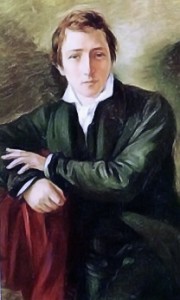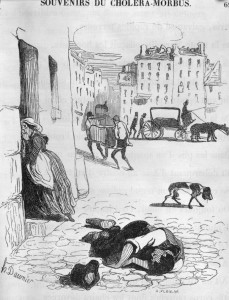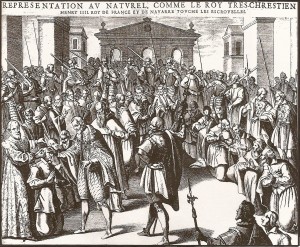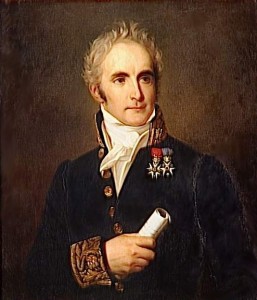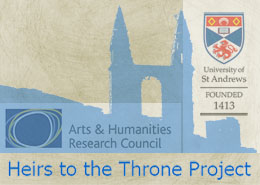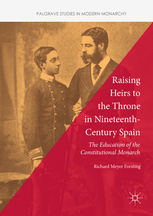The Prince, the President and the Cholera
Heidi Mehrkens
One fine day back in April 1832, while staying in Paris, the German poet Heinrich Heine had the impression that writing was becoming an increasingly difficult task: “I felt much disturbed at work”, he wrote sarcastically in an article for the Augsburg Gazette, “mostly by the gruesome screaming of my neighbour who was dying of cholera.” The Parisian spring clearly was no romantic experience that year, neither for Heine nor for the other inhabitants of the capital – including the royal family. The “Citizen King” Louis-Philippe of Orleans who had come to power only two years previously after the 1830 Revolution, faced the severe task of calming a furious population struck by the cruel epidemic that had reached Paris end of March 1832.
While thousands of people were dying at home and in the hospitals – according to official figures there were some 18,000 deaths – and uprisings were keeping the military in a high state of alert, the royal family stayed in Paris. This proof of sangfroid earned the dynasty respect even from the July Monarchy’s opponents, since many nobles had decided to get themselves out of harm’s way and head for the countryside. During the crisis, the royal family dedicated much of their time and a considerable amount of money to helping the persons affected by cholera. Queen Marie Amelie gave away waistbands she had sewn herself from flannel (a cure Heine also applied: “I am wrapped in flannel up to my neck and methinks I am cholera-proof now!”). The children of the royal family were still seen in public; the Duke of Aumale, ten years old, went to school as usual and, after he had finished his homework, distributed soup to the poor. The young princes and princesses all contributed to the subscription on behalf of the suffering from their pocket money.
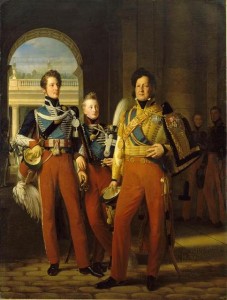
Portrait of Louis-Philippe of Orleans with his two eldest sons, the Duke of Chartres (future Duke of Orleans) and the Duke of Nemours by Louis Hersent (1830)
The King’s eldest son, dashing 22-year-old Prince Ferdinand Philippe, Duke of Orleans, was singled out for special praise in the regime-friendly Parisian newspapers. Le Nouvelliste wrote on 31 March: “In the last three months, 2,000 rations of food have been distributed in the different quarters of Paris, at the expense of the Duke of Orleans. We learn that His Royal Highness intends to add to this benefaction a distribution of medicines. It was by chance that we became acquainted with this new act of humanity, which will not surprise anyone.”
The young crown prince had already earned the reputation of a philanthropist; he did not intend to leave it at charitable donations. On 1 April 1832, Ferdinand Philippe went in person to the hospital of the Hôtel de Dieu and visited the cholera patients, accompanied by the president of the council Casimir Pierre Perier. Both men showed great courage in order to demonstrate the closing of ranks between two leading institutions of the French state, the monarchy and its government, during the crisis: It was a considerable risk to expose oneself to victims since there was no scientific knowledge of the cause and transmission of cholera until the discoveries of John Snow (1854) and Robert Koch (1883) helped to further explain the disease.
Evenly concerned and deeply impressed by the foolhardiness of the successor to the throne, Leopold I, King of the Belgians, sent a letter to Ferdinand: “You have shown […] courage more noble and calm than many men who have experienced long military campaigns. Walking right into the centre of this horrible illness, which is, as your physicians claim, contagious, will forever stand as a beautiful historic action; in all good and noble hearts you will maintain a lively and lasting recognition.”
The crown prince repeated this act of bravado by spending time with cholera patients at the military hospital of Val de Grace; the London Times appreciated that “to every one […] he spoke with kindness and encouragement, taking the hands of many to ascertain the degree of their disease.” The French anti-monarchical party, on the other hand, was not at all impressed by the prince’s humanitarian commitment and distributed agitating proclamations: “The cholera is a plague less cruel than Louis-Philippe’s government. Louis-Philippe sends his son to the Hôtel de Dieu so that he can observe the misery of the people from close-by.” The revolutionaries were not the only opposition. With both the legitimist Bourbon and the Bonapartist pretender waiting impatiently for their dynasty to return to power in the early 1830s, the Orleans family worked tirelessly towards stabilizing the July Monarchy.
Catherine J. Kudlick has hinted at the fact that ideas of religious and secular authority were constantly in motion in post-revolutionary France and that crises like the cholera epidemic further stimulated negotiation of authorities. Commissioned by the king, Alfred Johannot painted the encounter of the crown prince and President Perier with the people affected by the disease: “Le duc d’Orléans visitant les malades de l’Hôtel-Dieu pendant l’épidémie de cholera” (1832) depicts Ferdinand Philippe in uniform, surrounded by patients and their relatives, his right hand raised in what resembles the act of a Christian saint giving a blessing. This carefully arranged piece of political art evoked the association of the “king’s touch” (touche des écrouelles), which was based on the ancient belief that the kings of France and England could heal scrofula (“the king’s evil”) by touching the abscesses. Louis XVI had practiced the rite at Versailles, the miracle of healing manifesting his divine right to reign. The ceremony was last performed during the coronation of Charles X in 1825 (when in fact it had lost most of its awe and already seemed strangely out of place for a 19th century monarchy).
Even though the idea of the doctrine of divine right faded over time and the notion of a king – or his royal offspring – magically healing by touch was difficult to sell in 1830 France, Johannot’s artistic interpretation invited the viewer to regard Ferdinand Philippe as the Bourbon’s rightful successor. Moreover, both the crown prince’s visit to the hospital and Johannot’s art wove another thread into the history of France’s heroic monarchs: Jean Antoine Gros’s painting of “Napoleon Bonaparte Visiting the Plague-Stricken in Jaffa” (1808) glorified the future Emperor’s act of courage in 1799, when he exposed himself to the disease. Gros, like Johannot, arranged the composition of the painting around the protagonist’s magical gesture, transforming Napoleon into a saint-like figure, a modern type of Christian saviour.
On a very worldly level the administration of the July Monarchy – the regime was known for its anticlericalism – had taken over the Church’s traditional responsibilities to cope with the cholera crisis. It was noted in the press that the Archbishop of Paris also visited the hospital, but only after the crown prince and the president of the council had been there. The government coordinated the large part of the collection and distribution of relief efforts. “Charity gave a powerful voice of authority to whoever could claim to run it.” (Kudlick)
The crown prince’s visit to the hospital thus became charged with a highly political meaning intended to reinforce the dynasty’s public acceptance. First, Ferdinand Philippe appeared as the rightful successor in a long line of ancestors claiming the throne of France. Secondly the crown prince embodied the future of a secular, charitable monarchy, promoting progress, caring for its subjects and sharing power with elected institutions. Casimir Perier represented the new bourgeois political elite promoted by the July Monarchy: son of a rich banker and manufacturer, former president of the French house of deputies, he often opposed the king as president of the council and chief of the “party of resistance”.
By a cruel irony of fate, the visit at the Hôtel de Dieu marked the end of Perier’s career: Johannot’s painting shows the minister in the shadows behind Ferdinand Philippe, his face has an otherworldly expression; the skin is pale and greenish… Of delicate constitution, the prime minister fell ill directly after the visit and died in terrible agony of cholera on 16 May 1832. The crown prince attended his funeral. “A deathly silence is hovering over Paris”, wrote Heine.
Suggested Reading
Marc Bloch: Les rois thaumaturges. Étude sur le caractère surnaturel attribué à la puissance royale particulièrement en France et en Angleterre, Paris 1924.
Richard J. Evans: Epidemics and Revolutions: Cholera in Nineteenth-Century Europe, in: Past & Present 120 (1988), p. 123-146.
Walter Friedlaender: Napoleon as “Roi Thaumaturge”, in: Journal of the Warburg and Courtauld Institutes 4/3-4 (1941-1942), p. 139-141.
Heinrich Heine: Französische Zustände, Article 6, Paris, 19 April 1832 (Hoffmann & Campe 1833).
Catherine J. Kudlick: Giving is deceiving: Cholera, Charity, and the Quest for Authority in 1832, in: French Historical Studies 18/2 (1993), p. 457-481.
Paul Thureau-Dangin: Histoire de la monarchie de juillet (7 volumes), vol. 2, Paris, Librairie Plon, 1888, p. 106-115.
Images
Honoré Daumier : Souvenirs du choléra-morbus à Paris (Réf. image : 02536), Graveur : A. Plon ; extrait de François Fabre : Némésis médicale illustrée, Paris : Béthune et Plon, 1840. Permanent URL : http://www.biusante.parisdescartes.fr/histmed/image?02536
Henri IV, roi de France et de Navarre, touchant les écrouelles (Réf. image MEDIC@ : med26755x0043) ; extrait de Augustin Cabanès, Le costume du médecin en France, Paris : Laboratoires P. Longuet, 1921. Permanent URL : http://www.biusante.parisdescartes.fr/histmed/image?med26755x0043
Louise Adélaïde Desnos, née Robin (1807-1870): Portrait of Casimir Pierre Perier (1832). URL : http://commons.wikimedia.org/wiki/Casimir_Pierre_Perier
Louis Hersent (1777-1860): Portrait of Louis-Philippe of Orleans with his two eldest sons, the Duke of Chartres (future Duke of Orleans) and the Duke of Nemours (1830). URL: http://commons.wikimedia.org/wiki/File:Hersent_-_Le_duc_d%27Orl%C3%A9ans,_les_ducs_de_Chartres_et_de_Nemours_%281830%29.jpg?uselang=de
Moritz Daniel Oppenheim (1800-1882): Portrait of Heinrich Heine (1831). URL: http://commons.wikimedia.org/wiki/File:Heinrich-heine_1.jpg

